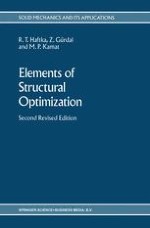
1990 | OriginalPaper | Buchkapitel
Introduction
verfasst von : Raphael T. Haftka, Zafer Gürdal, Manohar P. Kamat
Erschienen in: Elements of Structural Optimization
Verlag: Springer Netherlands
Enthalten in: Professional Book Archive
Aktivieren Sie unsere intelligente Suche, um passende Fachinhalte oder Patente zu finden.
Wählen Sie Textabschnitte aus um mit Künstlicher Intelligenz passenden Patente zu finden. powered by
Markieren Sie Textabschnitte, um KI-gestützt weitere passende Inhalte zu finden. powered by
Optimization is concerned with achieving the best outcome of a given objective while satisfying certain restrictions. Human beings, guided and influenced by their natural surroundings, almost instinctively perform all functions in a manner that economizes energy or minimizes discomfort and pain. The motivation is to exploit the available limited resources in a manner that maximizes output or profit. The early inventions of the lever or the pulley mechanisms are clear manifestations of man’s desire to maximize mechanical efficiency. Innumerable other such examples abound in the saga of human history. Douglas Wilde [1] provides an interesting account of the origin of the word optimum and the definition of an optimal design. We will paraphrase Wilde and offer the definition of an optimal design as being ‘the best feasible design according to a preselected quantitative measure of effectiveness’.